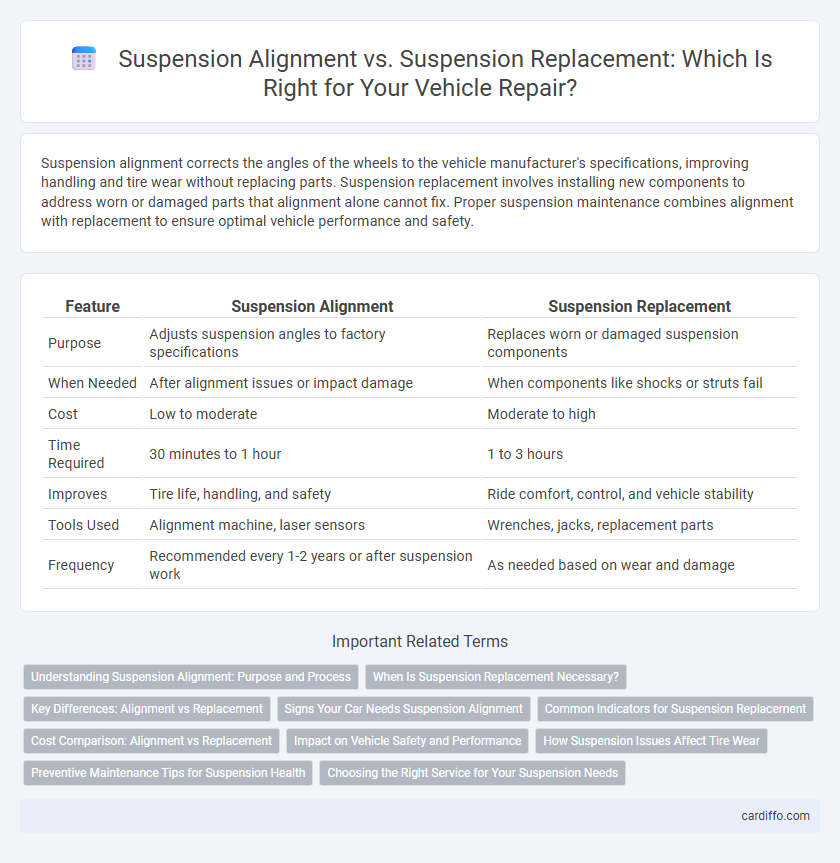Suspension alignment corrects the angles of the wheels to the vehicle manufacturer's specifications, improving handling and tire wear without replacing parts. Suspension replacement involves installing new components to address worn or damaged parts that alignment alone cannot fix. Proper suspension maintenance combines alignment with replacement to ensure optimal vehicle performance and safety.
Table of Comparison
| Feature | Suspension Alignment | Suspension Replacement |
|---|---|---|
| Purpose | Adjusts suspension angles to factory specifications | Replaces worn or damaged suspension components |
| When Needed | After alignment issues or impact damage | When components like shocks or struts fail |
| Cost | Low to moderate | Moderate to high |
| Time Required | 30 minutes to 1 hour | 1 to 3 hours |
| Improves | Tire life, handling, and safety | Ride comfort, control, and vehicle stability |
| Tools Used | Alignment machine, laser sensors | Wrenches, jacks, replacement parts |
| Frequency | Recommended every 1-2 years or after suspension work | As needed based on wear and damage |
Understanding Suspension Alignment: Purpose and Process
Suspension alignment involves adjusting the angles of the wheels to the manufacturer's specifications, ensuring optimal tire contact with the road, improved vehicle handling, and even tire wear. This process typically includes measuring and correcting camber, toe, and caster angles using specialized alignment equipment. Proper alignment can prevent premature suspension component wear, enhancing overall driving safety without the need for immediate suspension replacement.
When Is Suspension Replacement Necessary?
Suspension replacement is necessary when components such as struts, shocks, or control arms show significant wear, damage, or failure that alignment cannot correct. Signs include uneven tire wear, persistent pulling to one side, excessive bouncing, or visible leaks from shock absorbers. Professional inspection determines if alignment adjustments suffice or if full suspension replacement ensures vehicle safety and optimal performance.
Key Differences: Alignment vs Replacement
Suspension alignment involves adjusting the angles of suspension components to ensure proper tire contact with the road, improving vehicle handling and tire lifespan without replacing parts. Suspension replacement entails removing and installing new suspension parts such as shocks, struts, or control arms due to wear or damage, essential for restoring structural integrity and ride quality. While alignment corrects the geometry of existing components, replacement addresses mechanical failures and wear that alignment alone cannot fix.
Signs Your Car Needs Suspension Alignment
Uneven tire wear, a pulling sensation to one side while driving, and a crooked steering wheel are clear signs your car needs suspension alignment rather than a full suspension replacement. Suspension alignment corrects misaligned wheels, improving handling, tire longevity, and overall safety without the higher cost and labor involved in suspension replacement. Timely alignment prevents further damage to suspension components and maximizes vehicle performance.
Common Indicators for Suspension Replacement
Common indicators for suspension replacement include uneven tire wear, persistent vehicle pulling to one side, and excessive bouncing or swaying during driving. Suspension alignment issues often cause misalignment of the wheels, but ongoing noise, harsh vibration, and visible damage to components such as shocks or struts usually indicate the need for a full suspension replacement. Addressing these warning signs promptly ensures improved handling, enhanced safety, and prolonged tire life.
Cost Comparison: Alignment vs Replacement
Suspension alignment typically costs between $75 and $150, making it a cost-effective solution for correcting wheel angles and improving vehicle handling. In contrast, suspension replacement can range from $500 to $2,000 or more, depending on the parts and labor involved, as it entails replacing components like shocks, struts, or control arms. Choosing alignment over replacement saves money when problems are limited to misaligned suspension geometry, but extensive wear or damage often necessitates the higher cost of replacement.
Impact on Vehicle Safety and Performance
Proper suspension alignment ensures that tires contact the road correctly, enhancing vehicle stability, steering precision, and tire longevity, which directly impacts safety and performance. Suspension replacement is necessary when components are damaged or worn beyond adjustment, restoring the suspension system's structural integrity and ride quality. Neglecting alignment after replacement can lead to uneven tire wear and compromised handling, reducing overall vehicle safety and efficiency.
How Suspension Issues Affect Tire Wear
Suspension alignment directly influences tire wear by ensuring even pressure distribution across the tire surface, preventing premature uneven wear patterns. Suspension replacement becomes necessary when worn components cause misalignment that cannot be corrected through adjustments alone, leading to accelerated tire damage. Addressing suspension issues promptly extends tire lifespan, improves handling, and enhances vehicle safety by maintaining optimal contact between tires and road.
Preventive Maintenance Tips for Suspension Health
Regular suspension alignment ensures even tire wear and improves vehicle handling, significantly extending the lifespan of suspension components. Inspecting and adjusting alignment every 12,000 miles or annually prevents uneven stress that can lead to premature suspension replacement. Incorporating alignment checks into routine preventive maintenance reduces repair costs and maintains optimal suspension health.
Choosing the Right Service for Your Suspension Needs
Suspension alignment corrects the angles of your wheels to ensure proper contact with the road, enhancing tire life and vehicle handling, while suspension replacement involves installing new components when parts are worn or damaged beyond repair. Selecting the right service depends on diagnosing the suspension's condition through visual inspections and test drives, identifying issues such as uneven tire wear, pulling, or poor steering response. Professional assessment ensures alignment adjustments suffice or if full suspension replacement is necessary for safety and performance restoration.
Suspension alignment vs suspension replacement Infographic

 cardiffo.com
cardiffo.com